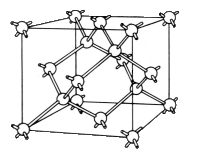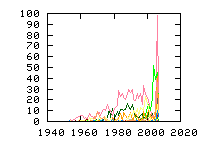« Previous
1
Next »
(5 hits, 1/1)
Showing
10, 25, 50, 100, 500, 1000, all papers per page.
Sort by:
last publication date,
older publication date,
last update date.
- 1. Sov. Phys. Semicond. 5, 1930 (1972) , “EPR of Zinc Atoms in p-Type Silicon”, V. B. Ginodman, P. S. Gladkov, B. G. Zhurkin, B. V. Kornilov.Zinc is a double accepter in silicon and it introduces two levels, E + 0.31 and E + 0.55 eV, into forbidden band [1,2]. The electrical and optical properties of zinc-doped silicon have been investigated by several workers [2-4]. A brief report of the observation of EPR in silicon is given in [5,6]: in these investigations the magnetic field H was perpendicular to the axis of compression of a crystal. Uniaxial compression gave rise to a structure in EPR spectrum of Zn67 and this structure was attributed to the hyperfine interaction of an unpaired hole with the magnetic moment of the Zn67 nucleus. The present paper describes the result of an investigation of the EPR of the Zn- state of zinc in p-type silicon doped with zinc in p-type silicon doped with zinc and phosphorus. The investigation was carried out at liquid helium temperature.
- 2. Appl. Phys. A 30, 1 (1983) , “Transition Metals in Silicon”, E. R. Weber.A review is given on the diffusion, solubility and electrical activity of 3d transition metals in silicon. Transition elements (especially, Cr, Mn, Fe, Co, Ni, and Cu) diffuse interstitially and stay in the interstitial site in thermal equilibrium at the diffusion temperature. The parameters of the liquidus curves are identical for the Si:Ti — Si:Ni melts, indicating comparable silicon-metal interaction for all these elements. Only Cr, Mn, and Fe could be identified in undisturbed interstitial sites after quenching, the others precipitated or formed complexes. The 3d elements can be divided into two groups according to the respective enthalpy of formation of the solid solution. The distinction can arise from different charge states of these impurities at the diffusion temperature. For the interstitial 3d atoms remaining after quenching, reliable energy levels are established from the literature and compared with recent calculations. (Read more)
- 3. Phys. Rev. Lett. 85, 417 (2000) , “Extreme Reduction of the Spin-Orbit Splitting of the Deep Acceptor Ground State of ZnS- in Si”, H. Schroth, K. L. La?mann, S. Vo?, H. Bracht.Electric-dipole spin resonance of the deep acceptor ZnS- in Si reveals close Γ8 and Γ7 ground states with zero-field separation of only 0.31 meV as compared to the 43 meV of the two valence bands. With Landé's formula for the g factors of a 2T2 state split by spin-orbit interaction into Γ8 and Γ7 this nearness can be interpreted as strong quenching of the orbital moment. The observed dependence on the Zn isotopic mass indicates a dynamic contribution of the acceptor atom to the electronic state as is expected for a Jahn-Teller effect. (Read more)
- 4. Phys. Rev. B 74, 144432 (2006) , “Role of defects in ferromagnetism in Zn1−xCoxO: A hybrid density-functional study”, C. H. PattersonExperimental studies of Zn1−xCoxO as thin films or nanocrystals have found ferromagnetism and Curie temperatures above room temperature and that p- or n-type doping of Zn1−xCoxO can change its magnetic... (Read more)
- 5. Nature 442, 436 (2006) , “Atom-by-atom substitution of Mn in GaAs and visualization of their hole-mediated interactions”, D. Kitchen, A. Richardella, J. -M. Tang, M. E. Flatt, A. YazdaniThe discovery of ferromagnetism in Mn-doped GaAs1 has ignited interest in the development of semiconductor technologies based on electron spin and has led to several proof-of-concept spintronic devices2, 3, 4. A major hurdle for realistic applications of Ga1-XMnXAs, or other dilute magnetic semiconductors, remains that their ferromagnetic transition temperature is below room temperature. Enhancing ferromagnetism in semiconductors requires us to understand the mechanisms for interaction between magnetic dopants, such as Mn, and identify the circumstances in which ferromagnetic interactions are maximized5. Here we describe an atom-by-atom substitution technique using a scanning tunnelling microscope (STM) and apply it to perform a controlled study at the atomic scale of the interactions between isolated Mn acceptors, which are mediated by holes in GaAs. High-resolution STM measurements are used to visualize the GaAs electronic states that participate in the Mn–Mn interaction and to quantify the interaction strengths as a function of relative position and orientation. Our experimental findings, which can be explained using tight-binding model calculations, reveal a strong dependence of ferromagnetic interaction on crystallographic orientation. This anisotropic interaction can potentially be exploited by growing oriented Ga1-XMnXAs structures to enhance the ferromagnetic transition temperature beyond that achieved in randomly doped samples. (Read more)
« Previous
1
Next »
(5 hits, 1/1)
Showing
10, 25, 50, 100, 500, 1000, all papers per page.
Sort by:
last publication date,
older publication date,
last update date.
All papers (3399)
Updated at 2010-07-20 16:50:39
Updated at 2010-07-20 16:50:39
(view as: tree
,
cloud
)
| 1329 | untagged |
Materials
(111 tags)
Others(101 tags)
Technique
(46 tags)
Details
(591 tags)
Bond(35 tags)
Defect(interstitial)(18 tags)
Defect(vacancy)(15 tags)
Defect-type(19 tags)
Element(65 tags)
Energy(8 tags)
Isotope(56 tags)
Label(303 tags)
Sample(17 tags)
Spin(8 tags)
Symmetry(15 tags)

